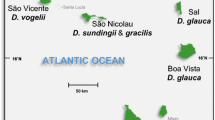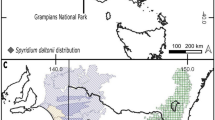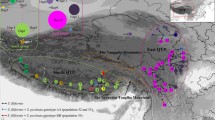Abstract
Extinction of biodiversity due to human activities is a severe global problem. In Europe, however, only a few plant species died out so far. We investigated a dubious, disregarded taxon—Saxifraga oppositifolia subsp. amphibia—which became extinct in the 1960s. It exclusively occurred in a specific niche, namely in seasonally flooded waterside bank vegetation around Lake Constance in Germany and Switzerland. It has either been interpreted as a glacial relict or as a recent dealpine taxon. Using herbarium material, we conducted phylogenetic analyses based on ITS and cpDNA sequence variation. The taxon shared a chloroplast haplotype of S. oppositifolia, which is mainly distributed in the Alps, favouring the dealpine hypothesis. Nuclear data revealed several paralogous copies nested inside S. oppositifolia, most of which, however, differed from other S. oppositifolia accessions including those from the vicinity of Lake Constance. The oldest mean stem node ages of these ITS copies date between 0.91 and 0.28 my. Contradicting cpDNA, this may indicate that this saxifrage was a distinct taxon and possibly a relict originating in Middle Pleistocene glaciations. If so, the present study exemplifies that arctic-alpine plants survived in specific niches at low altitudes during interglacials and that corresponding taxa with a limited distribution are especially prone to extinction.



Similar content being viewed by others
References
Abbott RJ, Comes HP (2004) Evolution in the Arctic: a phylogeographic analysis of the circumarctic plant, Saxifraga oppositifolia (Purple saxifrage). New Phytol 161:211–224
Abbott R, Chapman H, Crawford R, Forbes D (1995) Molecular diversity and derivations of populations of Silene acaulis and Saxifraga oppositifolia from the high Arctic and more southerly latitudes. Mol Ecol 4:199–208
Álvarez I, Wendel JF (2003) Ribosomal ITS sequences and plant phylogenetic inference. Mol Phylogenet Evol 29:417–434
Barluenga M, Meyer A (2005) Old fish in a young lake: stone loach (Pisces: Barbatula barbatula) populations in Lake Constance are genetically isolated by distance. Mol Ecol 14:1229–1239
Baumann E (1911) Die Vegetation des Untersees (Bodensee). Eine floristisch-kritische und biologische Studie. Arch Hydrobiol Suppl. 1:1–554
Blom C, Voesenek L (1996) Flooding: the survival strategies of plants. Trends Ecol Evol 11:290–295
Braendle R, Crawford RM (1999) Plants as amphibians. Perspect Plant Ecol Evol Syst 2:56–78
Braun-Blanquet J (1923) 58. Fam. Saxifragaceae Steinbrechgewächse. In: Hegi G (ed) Illustrierte Flora von Mittel-Europa 4. Carl Hanser, Munich, pp 562–657
Brochmann C, Nilsson T, Gabrielsen T (1996) A classic example of postglacial allopolyploid speciation re-examined using RAPD markers and nucleotide sequences: Saxifraga osloensis (Saxifragaceae). Symb Bot Upsal 31:75–89
Clement M, Posada D, Crandall KA (2000) TCS: a computer program to estimate gene genealogies. Mol Ecol 9:1657–1659
Crawford R (2004) Long-term plant survival at high latitudes. Bot J Scotl 56:1–23
Crawford R, Abbott R (1994) Pre-adaptation of Arctic Plants to Climate Change. Bot Acta 107:271–278
Crawford R, Chapman H, Smith L (1995) Adaptation to variation in growing season length in arctic populations of Saxifraga oppositifolia L. Bot J Scotl 47:177–192
Darriba D, Taboada G, Doallo R, Posada D (2012) jModelTest 2: more models, new heuristics and parallel computing. Nat Methods 9:772
Deng J, Drew BT, Mavrodiev EV, Gitzendanner MA, Soltis PS, Soltis DE (2015) Phylogeny, divergence times, and historical biogeography of the angiosperm family Saxifragaceae. Mol Phylogenet Evol 83:86–98
Dirzo R, Young HS, Galetti M, Ceballos G, Isaac NJ, Collen B (2014) Defaunation in the Anthropocene. Science 345:401–406
Drummond AJ, Bouckaert RR (2015) Bayesian evolutionary analysis with BEAST. Cambridge University Press, Cambridge
Drummond AJ, Suchard MA, Xie D, Rambaut A (2012) Bayesian phylogenetics with BEAUti and the BEAST 1.7. Mol Biol Evol 29:1969–1973
Eidesen PB et al (2013) Tetraploids do not form cushions: association of ploidy level, growth form and ecology in the High Arctic Saxifraga oppositifolia L. s. lat. (Saxifragaceae) in Svalbard. Polar Res 32
Engler HGA, Irmscher E (1919) Saxifraga. In: Engler HGA (ed) Das Pflanzenreich 69, IV. 117. Wilhelm Engelmann, Leipzig, pp 1–709
Escobar García P et al (2012) Extensive range persistence in peripheral and interior refugia characterizes Pleistocene range dynamics in a widespread Alpine plant species (Senecio carniolicus, Asteraceae). Mol Ecol 21:1255–1270
Gabrielsen T, Bachmann K, Jakobsen K, Brochmann C (1997) Glacial survival does not matter: RAPD phylogeography of Nordic Saxifraga oppositifolia. Mol Ecol 6:831–842
Gugerli F (1997) Sexual reproduction in Saxifraga oppositifolia L. and Saxifraga biflora All. (Saxifragaceae) in the Alps. Int J Plant Sci 158:274–281
Guindon S, Gascuel O (2003) A simple, fast, and accurate algorithm to estimate large phylogenies by maximum likelihood. Syst Biol 52:696–704
Hegi G (1905) Beiträge zur Pflanzengeographie der bayerischen Alpenflora. V. Höfling, Munich
Hess HE, Landolt E, Hirzel R (1977) Flora der Schweiz und angrenzender Gebiete 2. Birkhäuser, Basel
Hewitt GM (1999) Post-glacial re-colonization of European biota. Biol J Linn Soc 68:87–112
Holderegger R, Abbott RJ (2003) Phylogeography of the Arctic-Alpine Saxifraga oppositifolia (Saxifragaceae) and some related taxa based on cpDNA and ITS sequence variation. Am J Bot 90:931–936
Holderegger R, Stehlik I, Abbott R (2002) Molecular analysis of the Pleistocene history of Saxifraga oppositifolia in the Alps. Mol Ecol 11:1409–1418
Hooper DU et al (2012) A global synthesis reveals biodiversity loss as a major driver of ecosystem change. Nature 486:105–108
IUCN (2016) Red List. http://www.iucnredlist.org/
Katoh K, Misawa K, Ki Kuma, Miyata T (2002) MAFFT: a novel method for rapid multiple sequence alignment based on fast Fourier transformation. Nucleic Acids Res 30:3059–3066
Kay KM, Whittall JB, Hodges SA (2006) A survey of nuclear ribosomal internal transcribed spacer substitution rates across angiosperms: an approximate molecular clock with life history effects. BMC Evol Biol 6:36
Kearse M et al (2012) GENEIOUS Basic: an integrated and extendable desktop software platform for the organization and analysis of sequence data. Bioinformatics 28:1647–1649
Lang G (1967) Die Ufervegetation des westlichen Bodensees. Arch Hydrobiol Suppl. 32:437–574
Magallon S, Gomez-Acevedo S, Sanchez-Reyes LL, Hernandez-Hernandez T (2015) A metacalibrated time-tree documents the early rise of flowering plant phylogenetic diversity. New Phytol 207:437–453
Peintinger M, Prati D, Winkler E (2007) Water level fluctuations and dynamics of amphibious plants at Lake Constance: long-term study and simulation. Perspect Plant Ecol Evol Syst 8:179–196
Pimm SL et al (2014) The biodiversity of species and their rates of extinction, distribution, and protection. Science 344:1246752
Poczai P, Hyvönen J (2010) Nuclear ribosomal spacer regions in plant phylogenetics: problems and prospects. Mol Biol Rep 37:1897–1912
Purvis A, Gittleman JL, Cowlishaw G, Mace GM (2000) Predicting extinction risk in declining species. Proc R Soc Lond B Biol Sci 267:1947–1952
Rambaut A, Drummond AJ (2007) TRACER v1. 4. http://www.treebioedacuk.com/software/tracer
Roth von Schreckenstein F (1799) Verzeichniss sichtbar blühender Gewaechse, welche um den Ursprung der Donau und des Nekars, dann um den untern Theil des Bodensees vorkommen. Zieglerische Buchdruckerey, Winterthur
Schneeweiss G, Schönswetter P (2010) The wide but disjunct range of the European mountain plant Androsace lactea L. (Primulaceae) reflects Late Pleistocene range fragmentation and post-glacial distributional stasis. J Biogeogr 37:2016–2025
Schönswetter P, Stehlik I, Holderegger R, Tribsch A (2005) Molecular evidence for glacial refugia of mountain plants in the European Alps. Mol Ecol 14:3547–3555
Schröter C, Kirchner O (1902) Die Vegetation des Bodensees. Schr Ver Gesch Bodensees Lindau 9:1–86
Sebald O (1992) Saxifragaceae. In: Sebald O, Seybold S, Philippi G (eds) Die Farn- und Blütenpflanzen Baden-Württembergs 3. Ulmer, Stuttgart, pp 254–274
Simmons MP, Ochoterena H (2000) Gaps as characters in sequence-based phylogenetic analyses. Syst Biol 49:369–381
Stenström M, Molau U (1992) Reproductive ecology of Saxifraga oppositifolia: phenology, mating system, and reproductive success. Arct Alp Res 24:337–343
Sündermann F (1909) Zur Flora des Bodenseegebietes—Saxifraga oppositifolia var. amphibia. Mitt Bayer Bot Ges 2:190–192
Templeton AR, Crandall KA, Sing CF (1992) A cladistic analysis of phenotypic associations with haplotypes inferred from restriction endonuclease mapping and DNA sequence data. III. Cladogram estimation. Genetics 132:619–633
Thomas P, Dienst M, Peintinger M, Buchwald R (1987) Die Strandrasen des Bodensees. Veröffentlichungen für Naturschutz und Landschaftspflege in Baden-Württemberg 61:325–346
Vargas P (2003) Molecular evidence for multiple diversification patterns of alpine plants in Mediterranean Europe. Taxon 52:463–476
Webb DA (1964) Saxifraga. In: Tutin TG, Heywood VH, Burges NA, Valentine DH, Walters SM, Webb DA (eds) Flora Europaea 1. University Press, Cambridge, pp 364–380
Wessels M (1998) Geological history of the Lake Constance area. Arch Hydrobiol, Special Issue Advances in Limnology 53:1–12
Winkler M et al (2012) Tales of the unexpected: phylogeography of the arctic-alpine model plant Saxifraga oppositifolia (Saxifragaceae) revisited. Mol Ecol 21:4618–4630
Winkler M, Tribsch A, Schneeweiss GM, Brodbeck S, Gugerli F, Holderegger R, Schönswetter P (2013) Strong nuclear differentiation contrasts with widespread sharing of plastid DNA haplotypes across taxa in European purple saxifrages (Saxifraga section Porphyrion subsection Oppositifoliae). Bot J Linn Soc 173:622–636
Acknowledgements
We would like to thank Karin Wolf-Schwenninger (Stuttgart) for work at the scanning electron microscope, Bryan Drew (Kearney, Nebraska) for communicating data and three anonymous reviewers for their helpful comments on a first version of the manuscript.
Author information
Authors and Affiliations
Corresponding author
Ethics declarations
Conflict of interest
The authors declare that they have no conflict of interest.
Declaration of authorship
MT designed the study. CK and MT performed the experiments and analysed the data. CK, AW and MT wrote the paper.
Electronic supplementary material
Below is the link to the electronic supplementary material.
Rights and permissions
About this article
Cite this article
Krause, C., Wörz, A. & Thiv, M. Molecular analysis of the extinct Central European endemic Saxifraga oppositifolia subsp. amphibia and its implications on glaciation biogeography. Alp Botany 127, 85–95 (2017). https://doi.org/10.1007/s00035-016-0183-5
Received:
Accepted:
Published:
Issue Date:
DOI: https://doi.org/10.1007/s00035-016-0183-5




